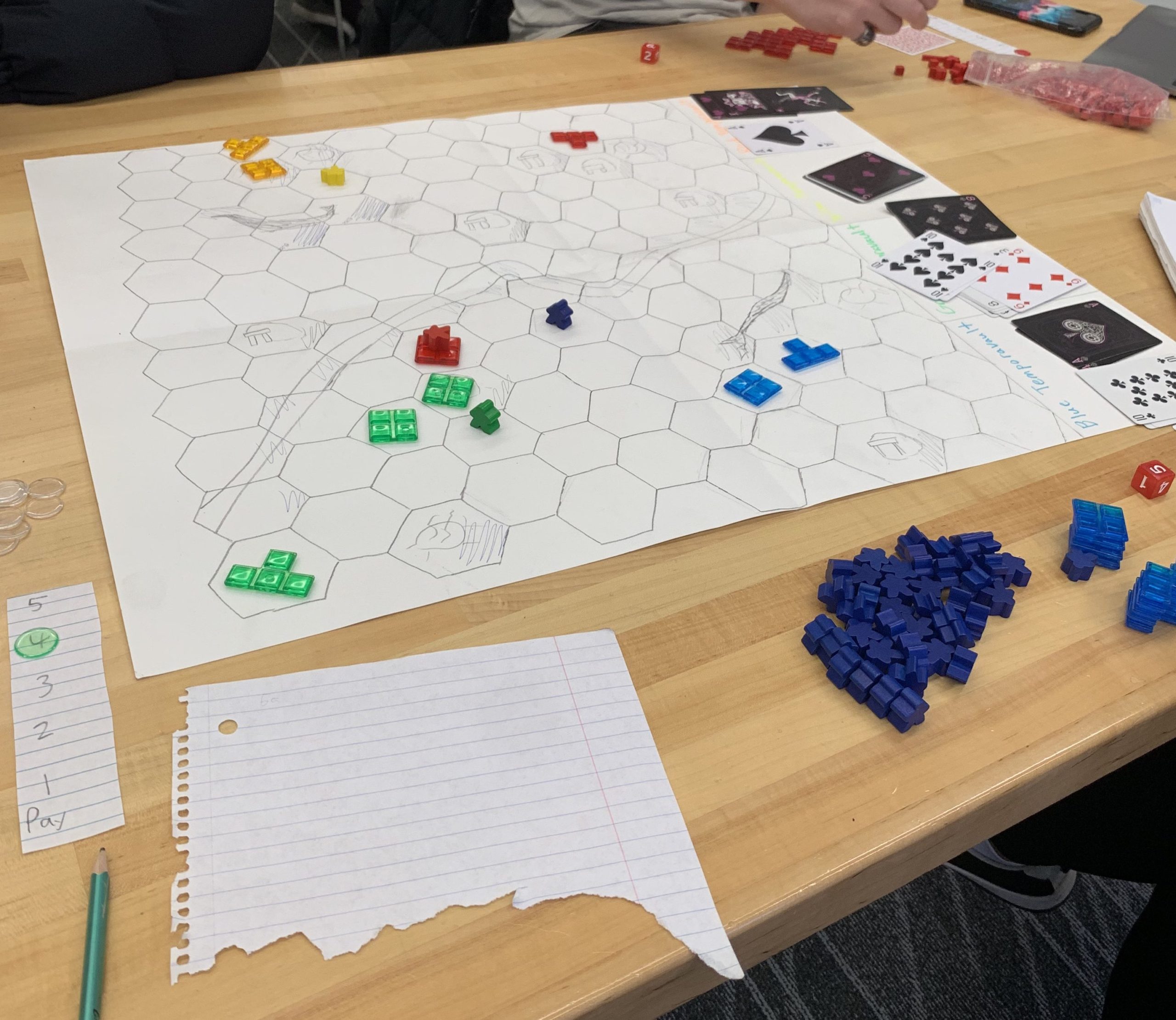Paid in Paradox, created by Austin Xie, is the game our team decided to become our final project. Paid in Paradox, originally referred to as simply Time-Travel Loan, is a wargame set in a futuristic environment, focused on gathering resources, building troops, and at times invading other players’ spaces. The main aspect of the game however is our time travel loan mechanic where players are able to loan resources or troops, but you have to pay it back by the time it’s your fifth turn, otherwise you create a paradox and consequences arise. The first player to reach seven research points, gained from building laboratories, wins the game. The other win condition can occur by destroying other players’ home base.
First Playthrough
Because we had previous experience from working with Raft Masters (see previous post), we were able to swiftly start playtesting in order to seek or iron out any problems of the game. For example, some early critiques included the lack of a limit on how many resources you could loan out. There was also an initially slow pace since not much progress could be made since players were more focused on repaying their debts instead of building new infrastructures.
However, by the end of our first playthrough and after finishing testing our other game ideas, we decided that Paid in Paradox’s was the game for us to commit to. We enjoyed the relationship built between players as we would build alliances, break them, trade with each other as well as threaten war as we fought for control of the board. To reach this point though, there are still some changes we need to make as we continue to further improve and refine this exciting project.
Since we decided on Paid in Paradox on Friday (1/13/23), our team has been working hard on making some upgrades. Down below, we’ll go into more detail of what changes have been made since then and what goals we have in mind to have completed for our final product.
Game Mechanic Updates & Rules
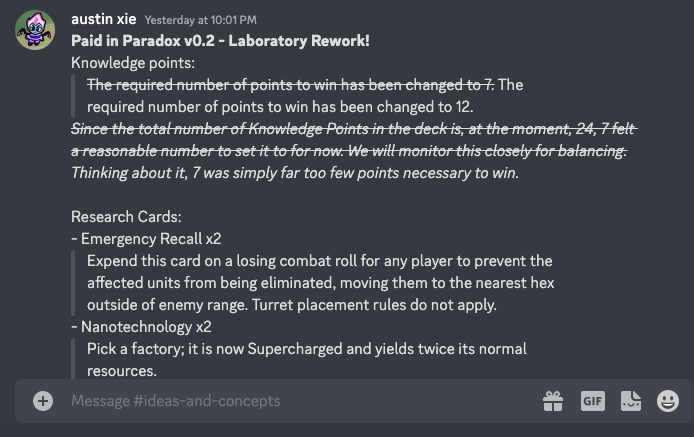
From our first playthrough, we mentioned multiple problems in the games pacing and balance, mainly how sometimes loaning resources could pause the game for some players, as well as the terribly balanced state of the Laboratories, the source of the non-combative win condition. Since then, the team has worked on fixing these problems, and currently our best solution has been implementing research cards.
Research cards serve as boosts players can gain from their Laboratories every turn, alongside “Breakthrough” cards, which give the player points they need to win the game. They’re similar to the development cards seen in Cata where they can aid players get ahead while also being balanced enough to not be overpowered. Even if we include overpowered cards, we plan to limit the amount of them so it doesn’t disrupt the game too much (ex. There are only 2 Monopoly cards in Catan).
So far, two patches have been made, and more are being made, suggested, or modified as we go further along. We keep these changes saved through small “patch notes” (as seen in the image above) as well as updating our current rulebook. In addition to working on the rulebook, work has been done on creating some engaging lore for players to enjoy and immerse themselves in.
Second Playthrough
On the second playthrough of the game, one of our main focuses was on updating some of the combat and building systems since we felt that with our current prototype, the game speed was a bit slow and lacking in action.
Here, we will quickly go over some of the most recent changes we’ve made:
- The cost of making turrets have decreased to cost as much as battalions
- Players begin the game with one battalion
- Supercharge mechanic now helps players reroll their die in order to gain a better score during combat
- Home bases, factories, and laboratories reward players with 1 influence point
- 10 influence points are needed to win
- Influence points can be gained from research cards
- When in paradox, cards do not give cards
- The map has been reword to only include a center river and four steel ravines
- Before we had geysers and mines
- You can take out a maximum debt of 10 items per resource
However, even with these implementations, we are still concerned about how this will affect the balance of the game, so we’re hoping that during the class playtest we’ll be able to take notes about what might need to be “nerfed” or improved upon.
Experience & Visual Design
Goals
We outlined three priorities for the experience and visual design of the game:
- Communication – How can the cards succinctly communicate the state of the game? How do the board and physical pieces facilitate readability for spectators? How are objectives and targets revealed to the players?
- Accessibility – Is the vocabulary in the rulebook appropriate for the reading level of our target audience? How can we resolve barriers to entry for individuals with sensory impairments? Does our game heavily rely on cultural references that may limit our audience?
- Thematics – How does the use of color and shape language convey tone? What types of humor are appropriate for the flavor text?
The game was originally framed as science fiction, broadly, but was narrowed to space fiction to complement the techno-futuristic, dystopian themes of resource extraction and militarization. Because the mechanics of Paid in Paradox drew heavily from wargames, we initially crafted the game with a more austere tone. However, as we proposed concrete visual designs and personas, we increasingly emphasized the absurdity of the game’s premise. The final tone of Paid in Paradox leans out of the seriousness of wargaming and into the emotional palette of Star Wars intermixed with elements of childhood imaginative play.
Tech Stack
The art assets for Paid in Paradox are created by Noor using a hybrid of three-dimensional modeling and two-dimensional rendering software. Mockups for the board pieces were produced in Blender and Photoshop, the card design and logo were created in Figma, and various background elements and textures were rendered in Cinema 4D.
Process
To begin to think holistically about the various game components, Noor visualized the board as a clay model, which describes a relatively unrefined and untextured model. The group noted that the variety of game pieces—from the four separate characters, various build options with upgrades, and different types of hexagons—would demand simple geometric shapes to facilitate readability while not overwhelming the player.
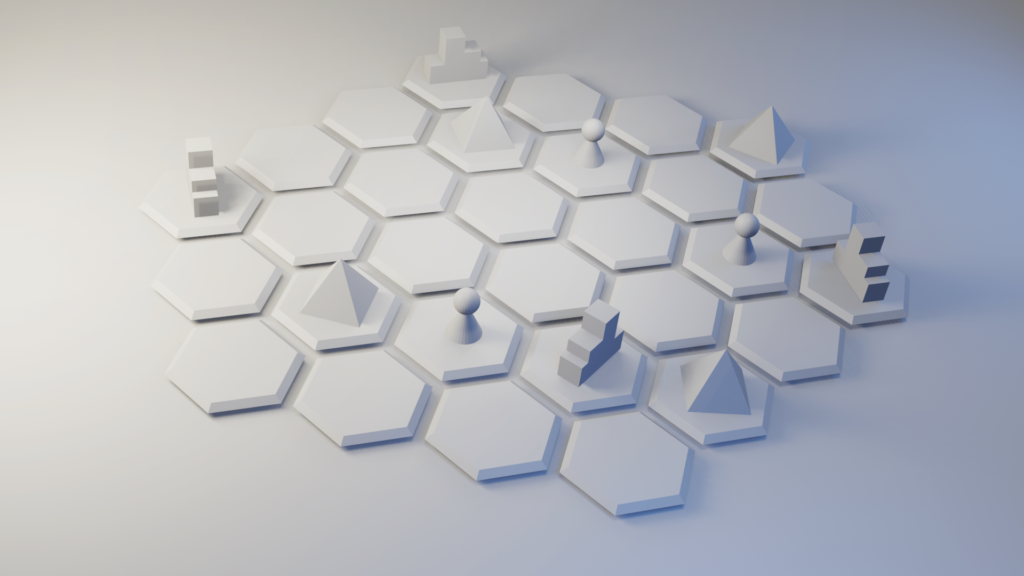
Noor also created a rough color pass on the hexagon art, but she decided to pivot to brand design to help concretize the tone of the game.
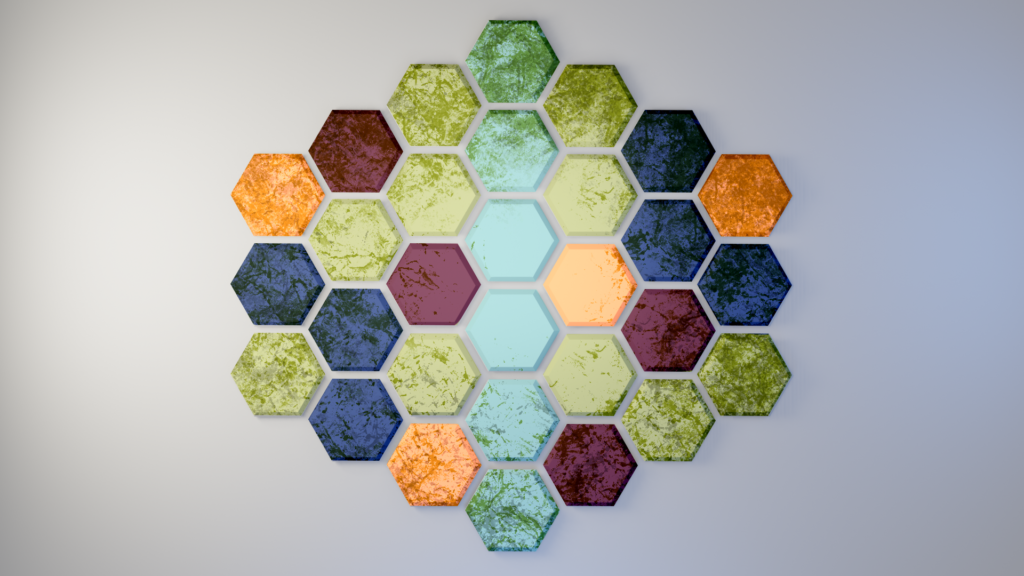
The core tension in Paid in Paradox’s brand design was marrying the organic, rounded shape language from space fiction with the angularity of the hexagons. Our initial logo opted for a stylized yet legible font called Neo Latina to foreground the space theme, while borrowing the O and X from the word “paradox” to contrast the title’s rounded and angular elements. However, we found that contrast harsh on the eyes and chose a simpler rounded hexagon shape for the final logo.
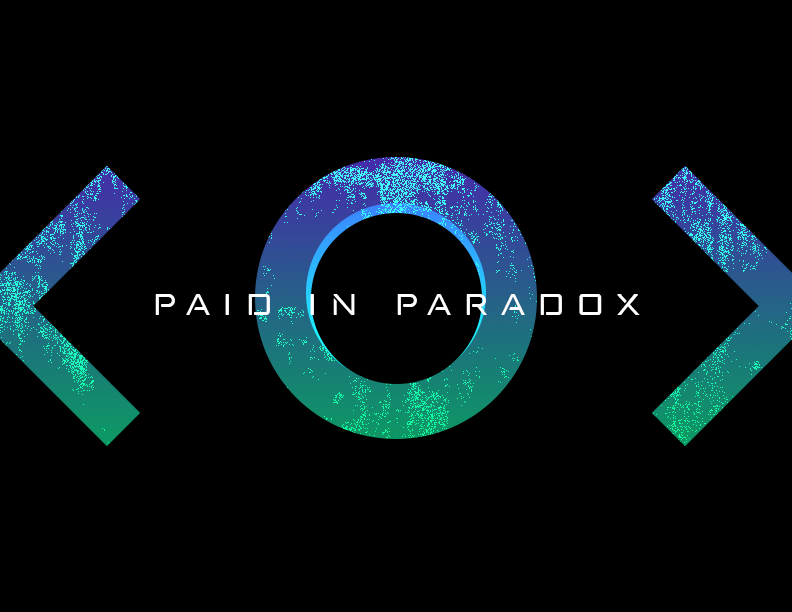
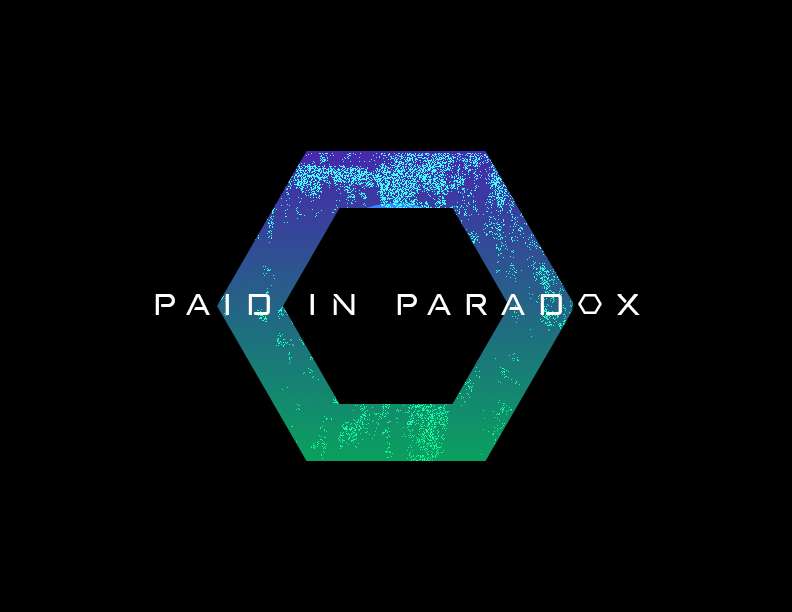
The last element we aimed to mockup was the cards. Our design offers a significant digression from traditional playing cards due to the demands to communicate different information to the player. Rather than 52 unique cards per deck, Paid in Paradox has categories of equivalent cards, such as resource and research cards. Specifically, our resource cards needed to convey the type of resource and whether the cards were accrued by the player’s factories/starting cards or loaned.
Noor’s mockup gave precedence to accessibility, complementing the highly distinguishable resource cards with large text to accommodate colorblind or visually-impaired players. We additionally avoided icons lacking semantic meaning—such as the suits of playing cards—which rely on prior learning to grasp. Katherine suggested that only one side of the card should have color, for which the colored side represents a resource owned by the player, while the grayscale side represents a loaned resource.
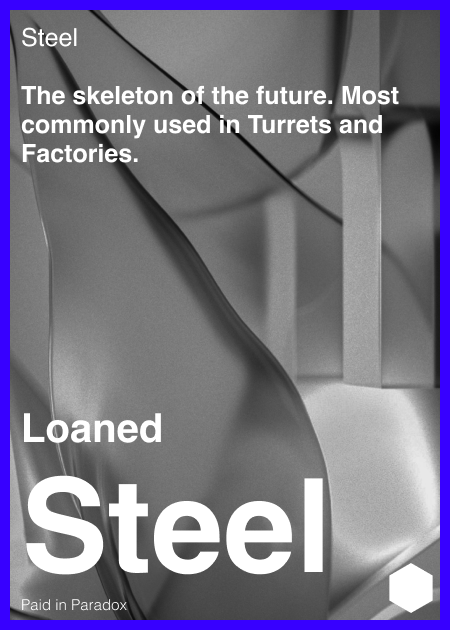
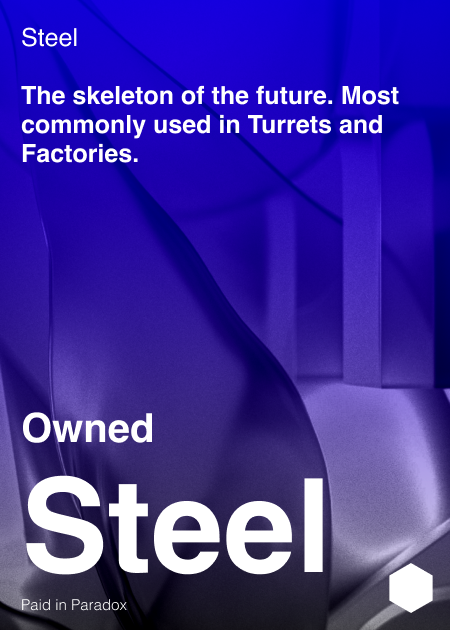
Challenges
While we have been able to overcome any problems we have faced during prototyping, our main challenge from now on is just making sure everything runs smoothly. In addition, our game will require many physical game components such as turrets, battalions, infrastructures, resource cards, and tokens. Throughout the upcoming week, we hope to realize these goals to our content, even if it requires learning new skills.First and foremost, our game will most likely require many 3D printed components, and while the majority of us have no experience with using these printers, Noor was nice enough to create a quick and detailed tutorial for it. Now, the work needed to complete these pieces is now spread out more evenly and we’ll be able to turn in a project that’s both fun to play and visually exciting. In addition, we are always keeping one another updated with our current progress, always open to receiving thoughts or critique. With the current pace and dedication everyone has demonstrated so far, we have confidence in completing Paid in Paradox to our satisfaction.
